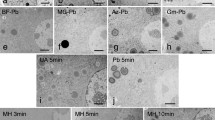Summary
A new technique for dry-mounting electron microscopic radioautography of water soluble-compounds has been established.
Tissues containing labelled compounds are cut as small as less than 1 mm in diameter, plunged into isopentane cooled to about −160° C with liquid nitrogen, and frozen-dried at −50° C for 24–48 hours. After drying, the tissues are embedded in Epon, which is polymerized according to the conventional procedure.
Ultrathin sectioning is accomplished with ethylene glycol instead of water in the knife trough so that water is not involved in the floatation and expansion of the ultrathin sections. Sections are picked up on collodion coated grid meshes from ethylene glycol.
Radioautographic emulsion is diluted 1 part in 10 parts with distilled water at 40° C. Ten ml of the diluted emulsion is added with 0.2 ml of 2 per cent aqueous solution of dioctyl sodium sulfosuccinate. A thin film of the emulsion is obtained by dipping a platinum wire loop into the emulsion. The loop is set on a flat surface of a desk for air-drying. The dried film is then applied to the mesh and it is warmed at 37° C for 1 hour in order to help the film to adhere to the mesh. Thus, dry-mounting of packed monolayers of radioautographic silver crystals can be constantly achieved. The mesh is then exposed, developed and stained according to the conventional technique.
Similar content being viewed by others
References
Andros, G., and S. H. Wollman: Autoradiography of diffusible ions with application to thyroidal radioiodide. J. Histochem. Cytochem. 13, 390–395 (1965).
Appleton, T. C.: Autoradiography of soluble labelled compound. J. roy. micr. Soc. 83, 277–281 (1964).
Blank, H., P. L. McCarthy, and E. P. DeLamater: A non-vacuum freezeing-dehydrating technic for hystology, autoradiography and microbial cytology. Stain Technol. 26 193–197 (1951).
Branton, D., and L. Jacobson: Dry, high resolution autoradiography. Stain Technol. 37, 239–242 (1962).
Fitzgerald, P. J.: “Dry”-mounting autoradiographic technic for intracellular localization of water-soluble compounds in tissue sections. Lab. Invest. 10, 846–856 (1961).
Gallimore, J. C., E. C. Bauer, and G. Boyd: A non-leaching technic for autoradiography. Stain Technol. 29, 95–98 (1954).
Hammarström, L., L. -E. Appelgren, and D. S. Ullberg: Improved method for light microscopy autoradiography with isotopes in water-soluble form. Exp. Cell Res. 37, 608–613 (1965).
Holt, M. W., R. F. Cowing, and S. Warren: Preparation of radioautographs of tissues without loss of water-soluble P32. Science 110, 328–329 (1949).
Kinter, W. B., L. L. Leape, and J. J. Cohen: Autoradiographic study of Diodrast-I131 transport in Necturus kidney. Amer. J. Physiol. 199, 931–941 (1960).
Miller, O. L., G. E. Stone, and D. M. Prescott: Autoradiography of soluble materials. J. Cell Biol. 23, 654–658 (1964).
Mizuhira, B., K. Uchida, J. Totsu, and H. Shindo: Studies on the absorption of S-benzoylthiamine O-monophosphate. IV. Electron microscopic autoradiography on the intestinal absorption of S-benzoylthiamine-3H O-monophosphate in rat. Vitamins (Japan) 38, 334–346 (1968).
Nagata, T., and T. Nawa: A modification of dry-mounting technique for radioautography of water-soluble compounds. Histochemie 7, 370–371 (1966).
—, and K. Shimamura: Radioautographic studies on calcium absorption. I. Calcium absorption in the stomach of rat. Med. J. Shinshu Univ. 3, 83–90 (1958).
Nawa, T., T. Nagata, S. Yokota, F. Murata, and S. Omochi: Two new models of freeze-drying apparatus for tissues. Med. J. Shinshu Univ. 14, in press (1969).
Pearse, A. G. E.: Histochemistry, theoretical and applied, 3rd ed. vol. 1, p. 50. London: J. & A. Churchill Ltd. 1968.
Pease, D. C.: Anhydrous ultrathin sectioning and staining for electron microscopy. J. ultrastruct. Res. 14, 379–390 (1966).
Salpeter, M. M., and L. Bachmann: Autoradiography with the electron microscope. A procedure for improving esolution, sensitivity, and contrast. J. Cell Biol. 22, 469–477 (1964).
Smitherman, T. C., A. F. Debons, J. A. Pittman, and V. Stephens: Movement of water-soluble material in Mayer's albumin and a simplified dry-mounting method for autoradiography. Nature (Lond.) 198, 499–500 (1963).
Stirling, C. E., and W. B. Kinter: High-resolution radioautography of galactose-3H accumulation in rings of hamster intestine. J. Cell Biol. 35, 585–604 (1967).
Stumpf, W., and L. J. Roth: High resolution autoradiography with dry mounted, freeze-dried frozen sections. Comparative study of six methods using two diffusible compounds 3H-estradiol and 3H-mesobilirubinogen. J. Histochem. Cytochem. 14, 274–284 (1966).
Stumpf, W. E., and L. J. Roth: Vacuum freeze-drying of frozen sections for dry-mounting, high-resolution autoradiography. Stain Technol. 39, 219–223 (1964).
Williams, A. I.: Method for prevention of leaching and fogging in autoradiographs. Nucleonics 8, 10–14 (1951).
Author information
Authors and Affiliations
Rights and permissions
About this article
Cite this article
Nagata, T., Nawa, T. & Yokota, S. A new technique for electron microscopic dry-mounting radioautography of soluble-compounds. Histochemie 18, 241–249 (1969). https://doi.org/10.1007/BF00306170
Received:
Issue Date:
DOI: https://doi.org/10.1007/BF00306170




